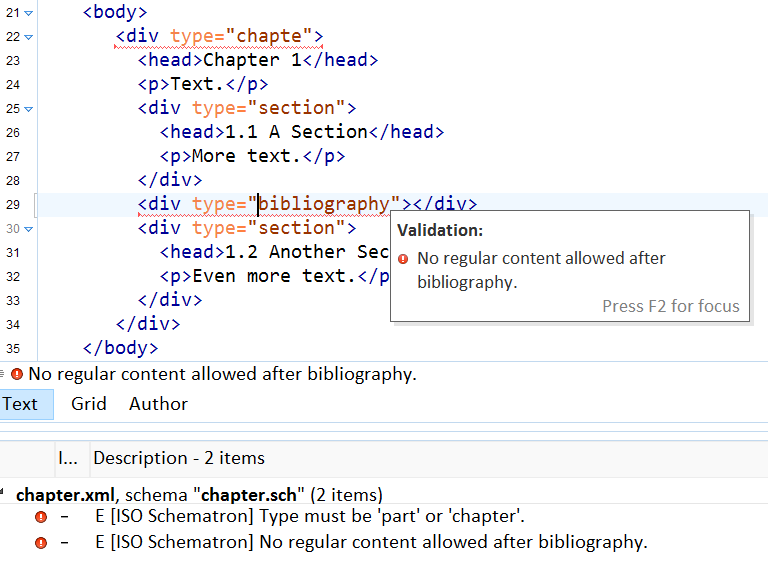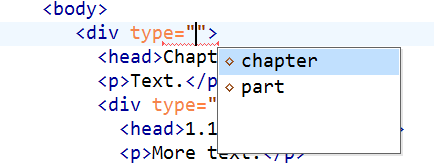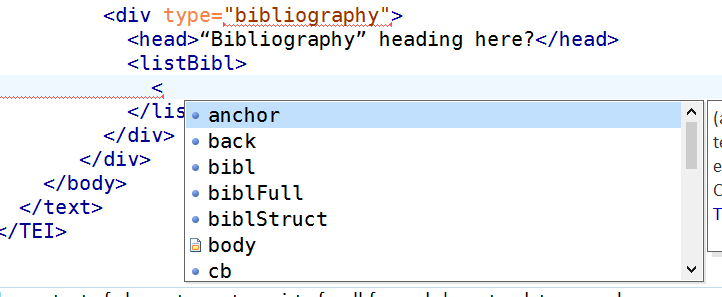A Text Structure “Epischema”
for TEI
Gerrit Imsieke (@gimsieke), le-tex publishing services GmbH (@letexml)
XML Prague, 2017-02-11
What this presentation is about
Schema customization, in particular:
Narrowing what is allowed in certain contexts
- that can be specified by a grammar
- that is applied on top of a base grammar
- that permits accurate and efficient content completion
- by adding a so-called epischema.
Descriptive vs. Prescriptive Schemas
- Descriptive
- flexibility to mark up diverse content
- Prescriptive
- enables authoring support
- predictability for conversion tools
Structural Divisions in TEI
<body>
<div>
<head>Chapter 1</head>
<p>Text.</p>
<div>
<head>1.1 A Section</head>
<p>More text.</p>
</div>
<div>
<head>1.2 Another Section</head>
<p>Even more text.</p>
</div>
</div>
</body>Structural Divisions in TEI
<body>
<div type="chapter">
<head>Chapter 1</head>
<p>Text.</p>
<div type="section">
<head>1.1 A Section</head>
<p>More text.</p>
</div>
<div type="section">
<head>1.2 Another Section</head>
<p>Even more text.</p>
</div>
</div>
</body>Further structural constraints: Bibliography
Bibliography divs should come after the sections. They should contain an optional head
that is followed by listBibl without a head.
<body>
<div type="chapter">
<head>Chapter 1</head>
<p>Text.</p>
<div type="section">
[…]
<div type="bibliography">
<head>“Bibliography” heading here?</head>
<listBibl>
<head>or here?</head>
<bibl n="1">Bibliographic Entry</bibl>
</listBibl>
</div>
</div>
</body>Further structural constraints: Floating Text
floatingText should be restricted to certain types (sidebar, box, letter, …)
<div type="section">
<head n="1.1">A Section</head>
<p>A paragraph.</p>
<floatingText type="box">
<body>
<div type="section">
<head>An interspersed Box</head>
</div>
</body>
</floatingText>
<p>Another paragraph.</p>
</div>Desirable features of a constraint mechanism
- No dependence on pre-existing schema design decisions
(content building block granularity, in particular) - No need to know the internal wirings of the base schema at all
- In-editor and batch validation support
- Context-dependent, constraint-aware content completion
How to enforce structural constraints?
Candidates:
- Extend the schema
- Schematron
- “Epischema”
Extend the schema
With RELAX NG, designing schemas that can be restricted without complete redefinition is more difficult than designing schemas that are easy to extend.
Eric van der Vlist (2003): RELAX NG, Ch. 12, Writing Extensible Schemas
Extend the schema
From the tei_allPlus.rng customziation:
<define name="div">
<element name="div">
<a:documentation>(text division)
contains a subdivision of the front, body,
or back of a text.</a:documentation>
<group> [49 lines]
<ref name="att.global.attributes"/>
<ref name="att.divLike.attributes"/>
<ref name="att.typed.attributes"/>
<ref name="att.declaring.attributes"/>
<empty/>
</element>
</define>No hooks for context-dependent div attributes
Extend the schema
- Lots of redundancy in forking
divinto context-dependent definitions. - TEI’s ODD metaschema language not (yet?) suited, either.
- Several other approaches conceivable:
- Annotation and transformation (Bob DuCharme, 2002)
- XSD 1.1 assertions
Extend the schema
Still:
- Knowledge and manipulation of base schema’s internal wirings necessary.
- XSD assertions are as (little) useful for content completion as Schematron.
Schematron
<pattern id="top-level-div">
<rule context="tei:body/tei:div">
<assert test="@type = ('part', 'chapter')">
Type must be 'part' or 'chapter'.</assert>
</rule>
</pattern>
<pattern id="chapter-div">
<rule context="tei:div[@type = 'chapter']/tei:div">
<assert test="@type = ('section', 'bibliography')">
Type must be 'section' or 'bibliography'.</assert>
</rule>
</pattern>Schematron
<pattern id="bib">
<rule context="tei:div[@type = 'bibliography']">
<report test="following-sibling::tei:div[@type =
('part', 'chapter', 'section')]">
No regular content allowed after bibliography.
</report>
</rule>
</pattern>…and several more rules
Schematron

Schematron
- orthogonal, non-invasive
- no content completion
- translating a complex grammar into assertions cumbersome
(although there is a tool for that)
Add a second grammar
Like this:
<?xml-model
href="https://www.tei-c.org/release/xml/tei/custom/schema/relaxng/tei_all.rng"
type="application/xml" schematypens="http://relaxng.org/ns/structure/1.0"?>
<?xml-model
href="http://www.le-tex.de/resource/schema/tei-cssa/docbook-like-divs.rng"
type="application/xml" schematypens="http://relaxng.org/ns/structure/1.0"?>
<TEI xmlns="http://www.tei-c.org/ns/1.0">
[…]Add a second grammar:
The “almost anything” pattern
start = tei-div-epi_anything
tei-div-epi_anything =
element * - (div | floatingText | listBibl) {
tei-div-epi_any-atts,
(text
| (tei-div-epi_floatingText-poetry
| tei-div-epi_floatingText-other
| tei-div-epi_front
| tei-div-epi_body ⇦
| tei-div-epi_back
| tei-div-epi_anything))*
}
| tei-div-epi_floatingText-poetry
| tei-div-epi_floatingText-otherAdd a second grammar (body)
tei-div-epi_body =
element body {
tei-div-epi_any-atts,
((tei-div-epi_part | tei-div-epi_anything)*
| (tei-div-epi_chapter⇦| tei-div-epi_anything)*)
}Add a second grammar (chapters, sections)
tei-div-epi_chapter =
element div {
attribute type { "chapter" },
tei-div-epi_not-type-atts,
tei-div-epi_sections,⇦
(tei-div-epi_glossary | tei-div-epi_bibliography)*
}
tei-div-epi_sections =
(tei-div-epi_section | tei-div-epi_anything)*
| (tei-div-epi_sect1 | tei-div-epi_anything)*
Add a second grammar (listBibl)
tei-div-epi_bibliography =
element div {
attribute type { "bibliography" },
tei-div-epi_not-type-atts,
element head {
tei-div-epi_any-atts, (text | tei-div-epi_anything)*
}?,
element listBibl { tei-div-epi_any-atts, bibl* }
}
bibl =
element bibl {
tei-div-epi_any-atts, (text | tei-div-epi_anything)*
}Add a second grammar
- orthogonal, non-invasive
- constricts as desired, at least with respect to validation
- in oXygen, only the first associated schema will be used for content completion
Wrap both schemas in NVDL
Document/schema association
<?xml-model type="application/xml"
href="http://www.le-tex.de/resource/schema/tei-cssa/tei_allPlus_docbook-like-divs.nvdl"
schematypens="http://purl.oclc.org/dsdl/nvdl/ns/structure/1.0"?>
<TEI xmlns="http://www.tei-c.org/ns/1.0">
[…]Wrap both schemas in NVDL
<rules xmlns="http://purl.oclc.org/dsdl/nvdl/ns/structure/1.0"
startMode="tei">
<mode name="tei">
<namespace ns="http://www.tei-c.org/ns/1.0">
<validate useMode="extensions" ⇦
schema="http://[…]/tei_allPlus.rng"/>
<validate useMode="allow"
schema="http://[…]/docbook-like-divs.rng"/>
</namespace>
</mode>Wrap both schemas in NVDL
<mode name="extensions">
<namespace ns="http://www.w3.org/1998/Math/MathML">
<attach/>
</namespace>
<namespace ns="http://www.w3.org/2000/svg">
<attach/>
</namespace>
</mode>
<mode name="allow">
<anyNamespace>
<allow/>
</anyNamespace>
</mode>
</rules>Wrap both schemas in NVDL
Looking good so far in oXygen 18.1:

Wrap both schemas in NVDL
However:

|

|
Thanks, George Bina!
Alternative Epischema Approaches
- XSD
- possible with XSD 1.1 (thanks to
xs:any/@notQName) - however, associating multiple XSDs not supported by tools
- possible with XSD 1.1 (thanks to
- HyTime Architectural Forms
- just kidding
- Good news: You can put a Relax NG epischema on top of any other base schema association mechanism (YMMV wrt your tools’ compound validation / content completion capabilities)
Other Epischema use cases
- Within TEI: limit what is allowed in
text/body/div - Prescriptive HTML authoring schemas
- don’t use
div, usesection - no paragraph-like content after a section ends
- context-aware
@classvalues - …
- don’t use
- DITA maybe?
Conclusion
Epischema
- it can be done
- it is useful
- tool support is on its way
- oXygen 19 due out in April, 2017
- it has a cool name
Thank you!

The full paper is on p. 195 of the XML Prague 2017 Proceedings
